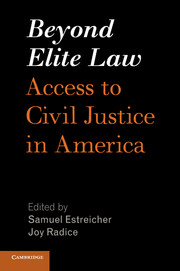Book contents
- Frontmatter
- Contents
- Beyond Elite Law
- Foreword
- List of Contributors
- Overview
- Overview
- PART I CURRENT STATE OF ACCESS TO LEGAL SERVICES
- PART II SOURCES OF LEGAL SERVICES ASSISTANCE FOR WORKING AMERICANS
- PART III FASHIONING A REFORM AGENDA
- PART IV CREATING A CULTURE OF SERVICE
- 43 Integrating Pro Bono with the Law Firm's Business
- 44 Facilitating Law Firm Pro Bono in Transactional Cases
- 45 What Bar Associations Can Do to Improve Access to Civil Justice
- 46 The Teaching Law Office: Service and Learning in the Law School Years
- 47 The Emergency-Room Law School Clinic
- 48 CUNY Law School's Community-Based and Community-Empowering Clinics
- 49 A New Law School in Texas to Address Unmet Legal Needs
- 50 Public Service Residency in Lieu of the Third Year of Law School
- Index
44 - Facilitating Law Firm Pro Bono in Transactional Cases
from PART IV - CREATING A CULTURE OF SERVICE
Published online by Cambridge University Press: 05 May 2016
- Frontmatter
- Contents
- Beyond Elite Law
- Foreword
- List of Contributors
- Overview
- Overview
- PART I CURRENT STATE OF ACCESS TO LEGAL SERVICES
- PART II SOURCES OF LEGAL SERVICES ASSISTANCE FOR WORKING AMERICANS
- PART III FASHIONING A REFORM AGENDA
- PART IV CREATING A CULTURE OF SERVICE
- 43 Integrating Pro Bono with the Law Firm's Business
- 44 Facilitating Law Firm Pro Bono in Transactional Cases
- 45 What Bar Associations Can Do to Improve Access to Civil Justice
- 46 The Teaching Law Office: Service and Learning in the Law School Years
- 47 The Emergency-Room Law School Clinic
- 48 CUNY Law School's Community-Based and Community-Empowering Clinics
- 49 A New Law School in Texas to Address Unmet Legal Needs
- 50 Public Service Residency in Lieu of the Third Year of Law School
- Index
Summary
In creating a culture of service, can law firms engage transactional lawyers in pro bono work too? In this chapter, Daniel Greenberg argues that firms can, if their pro bono programs move beyond litigation and incorporate transactional projects that build on the skills and knowledge of what their transactional lawyers do. At Greenberg's firm, their pro bono program successfully recruits volunteer transactional lawyers to represent nonprofits just like they represent their corporate clients advising on real estate issues, drafting contract language, or addressing intellectual property concerns. –Eds.
Any analysis of access to justice for Americans of average means must take note of the pro bono programs of major law firms. They are a huge potential source of advocacy for individual Americans of average means, and for the organizations that advocate for them. To maximize that potential, these firms will need to expand their services not by doing more of the same, but by rethinking the structure of their pro bono programs. This chapter argues that when a firm adopts a transactional pro bono model, thus transforming the scope of its services, not only will Americans of average means benefit, but the firm, its partners and associates will end up benefitting as well.
Historically, as is still the case in most law firms today, pro bono work has been tied to the firm's litigation practice. In the 1950s, the NAACP Legal Defense Fund, Inc. used courts to jump-start the civil rights movement. In 1963, President John F. Kennedy enlisted fifty of the country's largest law firms to work for equal justice through litigation with the creation of The Lawyers Committee for Civil Rights under Law. Framing large issues in law reform terms, and using class action litigation as its tool, private lawyers attacked segregation, discriminatory education and election laws, and other civil rights violations in federal courts that were largely sympathetic to their cause. Simultaneously, new legal services arose with a focus on the rights of poor people. These programs collaborated with big law firms in their quest for housing rights, access to government benefits, and consumer protections. Later, advocates in the women's, anti-war, and environmental movements emulated this model.
- Type
- Chapter
- Information
- Beyond Elite LawAccess to Civil Justice in America, pp. 636 - 644Publisher: Cambridge University PressPrint publication year: 2016



